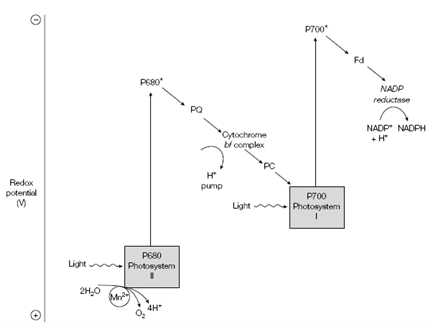Photosystems Iand II:
Algae and green plants use two kinds of photosystem known as photosystem I (PSI) and PSII (photosystem II). The chlorophyll in the reaction middle of PSI has an absorption maximum at 700 nm and so is known as P for pigment (P700) and in which the reaction center of PSII has an absorption maximum at 680 nm and so is known as P680. The two photosystems are linked through other electron carriers. When it arranged according to their redox potentials the several parts from the so-called Z scheme because the whole shape of the redox diagram looks such as a Z.

Figure: The Z scheme of noncyclic photophosphorylation in green plants. Note that the arrows in this diagram represent the sequence of events during photosynthesis, as described in the text, and are not metabolic interconversions.
The series of reactions during light absorption shown in the figure is as follows:
1. Light is harvested through the antenna complex chlorophylls of PSII and the energy is channeled towards the reaction center at that P680 is situated.
2. The excited P680 (P680*) emits a high-energy electron which passes to PQ (plastoquinone), a mobile quinone in the thylakoid membrane. This leaves P680 as the P680+ cation. The Plastoquinone accepts a total of two electrons and two H+ ions to form PQH2.
3. P680+ extracts an electron from water, frequent to its unexcited state. A removal of four electrons from two molecules of water needs four quanta of light to fall on PSII and leads to the production of four H+ ions and one molecule of O2:
4 photons
2H2O→4e-+4H++O2
This reaction is mediated through a cluster of four manganese ions (Mn2+) in PSII.
4. The electrons are now passed from PQH2 through the cytochrome bf complex (also known as cytochrome b6f complex) to plastocyanin (PC). PC is a copper- containing protein which accepts electrons through the copper cycling among Cu2+ and Cu+states:
Cytochrome b6f complex
PQH2+2 PC (Cu2+) →PQ+2 PC (Cu+) +2H+
5. Light energy falling onto the antenna complex of PSI is funneled to the reaction center. Now P700 is excited to P700* and emits a high-energy electron to ferredoxin and a protein which contains at least one FeS cluster, becoming the P700+ cation. The P700+receives the electron from PC and so returns to the unexcited state.
6. Two high-energy electrons from two molecules of decrease ferredoxin are now transferred to NADP+ to build NADPH. The reaction is carried out through NADP reductase.
NADP reductase
NADP++2e-+H+→ NADPH
Taking account of the entire series of electron transport and the reaction can be written as:
Light
2H2O+2NADP+→2 NADPH+2H++O2
showing which electrons flow from H2O to NADP+, reducing it to NADPH.